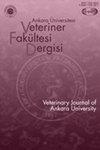土耳其的本土遗传资源:Muradiye kelbek鸽子
IF 0.9
4区 农林科学
Q3 VETERINARY SCIENCES
引用次数: 0
摘要
本研究旨在确定我国本土动物遗传资源之一穆拉迪耶克列贝克鸽的形态特征。为此,共有73只鸽子(35只公鸽和38只母鸽)来自6个饲养者。雄鸽的躯干长度(P < 0.001)、头宽(P < 0.05)、喙长(P < 0.001)、喙深(P < 0.05)、胸围(P < 0.001)和跗关节直径(P < 0.001)均高于雌鸽。2龄组体重、胸宽、胸围均高于1龄组(P < 0.05;P < 0.01;P < 0.001)。就头部结构而言,Muradiye kelebek鸽子类似于Muradiye dönek, Bursa oynarir, Thrace roller, Alabadem和Edremit kelebek鸽子的基因型。此外,Muradiye kelebek鸽的斑点羽色、Thrace rollers的豺羽色、Edremit kelebek鸽的斑点羽色、Muradiye dönek鸽的红黑相间的galaca羽色可能是这四种鸽子基因型的共同特征。因此,Muradiye kelebek鸽与5种基因型(Muradiye dönek、Alabadem、Bursa oynarir、Thrace roller、Edremit kelebek鸽)之间的亲缘程度应通过遗传学研究来确定。本文章由计算机程序翻译,如有差异,请以英文原文为准。
Turkey's indigenous genetic resource: Muradiye Kelebek pigeon
This research was carried out to determine the morphological characteristics of the Muradiye kelebek pigeon, which is one of our indigenous animal genetic resources. For this purpose, a total of 73 pigeons (35 male and 38 female) were examined from six breeders. Male pigeons were higher than the female pigeons in terms of trunk length (P < 0.001), head width (P < 0.05), beak length (P < 0.001), beak depth (P < 0.05), thoracic perimeter (P < 0.001), and tarsus diameter (P < 0.001). The body weight, chest width and thoracic perimeter of age group II were higher than those of age group I (P < 0.05; P < 0.01; P < 0.001). In terms of head structure, the Muradiye kelebek pigeons resemble Muradiye dönek, Bursa oynarı, Thrace roller, Alabadem, and Edremit kelebek pigeon genotypes. In addition, the plumage color of spotted in Muradiye kelebek pigeons, the plumage color of jackal in Thrace rollers, the plumage color of speckled in Edremit Kelebek pigeons, and the red/black galaca in Muradiye dönek pigeons may be mutual traits of these four pigeon genotypes. Therefore, the degree of kinship among Muradiye kelebek pigeons and the five pigeon genotypes (Muradiye dönek, Alabadem, Bursa oynarı, Thrace roller, Edremit kelebek pigeons) should be determined by genetic studies.
求助全文
通过发布文献求助,成功后即可免费获取论文全文。
去求助
来源期刊
CiteScore
1.50
自引率
0.00%
发文量
44
审稿时长
6-12 weeks
期刊介绍:
Ankara Üniversitesi Veteriner Fakültesi Dergisi is one of the journals’ of Ankara University, which is the first well-established university in the Republic of Turkey. Research articles, short communications, case reports, letter to editor and invited review articles are published on all aspects of veterinary medicine and animal science. The journal is published on a quarterly since 1954 and indexing in Science Citation Index-Expanded (SCI-Exp) since April 2007.

 求助内容:
求助内容: 应助结果提醒方式:
应助结果提醒方式:


